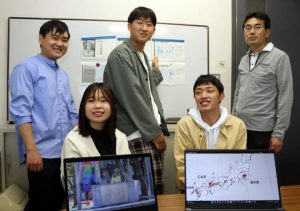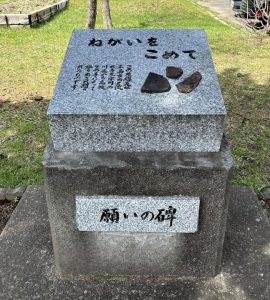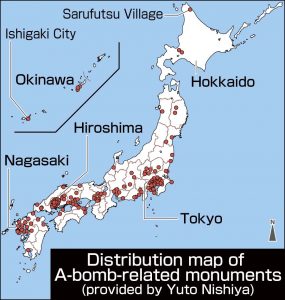Hiroshima University students identify 554 A-bomb monuments in 36 prefectures throughout Japan
May 16, 2022
by Rina Yuasa, Staff Writer
Four sophomores studying sociology in the school of education at Hiroshima University (located in Higashihiroshima City) have been engaged in the conduct of a survey about the distribution and characteristics of A-bomb-related monuments in Japan, starting in the spring of last year. Through the work, the group has confirmed a total of 554 such monuments in 36 prefectures across the country. “Each monument has a different background, depending on its location and time period it was erected, but the thoughts and feelings of those involved are imbued in all of them.” The group of students is scheduled to present the results of its survey at a spring conference of the Japanese Society for Geographical Sciences, which will be held online May 21.
The survey was initiated by 21 students taking a liberal arts course taught by Yasuhiro Kumahara, 47, associate professor of geography at Hiroshima University. After 356 monuments were identified, the four students, first-year students at the time, volunteered to continue the project. They met every week to search for and identify monument locations using the internet and Google Earth, geographical location software that utilizes satellite imagery. As of the present, the group has identified 237 monuments in Hiroshima City, 128 in Nagasaki City, and 189 in a variety of other locations across Japan. Takuya Akata, 19, expressed his surprise. “I had not expected there would be so many monuments in non-A-bombed cities.”
Northernmost monument located in village of Sarufutsu
According to the group, the monuments are broadly classified into those designed as a “memorial for A-bomb victims” and those expressing the “desire for abolition of nuclear weapons.” In the cities of Hiroshima and Nagasaki, many of the monuments were built between 1945 and 1979, a period during which the tuna fishing boat Daigo Fukuryu Maru was contaminated by a U.S. hydrogen bomb test at Bikini Atoll and the first World Conference Against Atomic and Hydrogen Bombs was held. Nagasaki has more monuments than Hiroshima expressing the desire for nuclear abolition. Maho Ichiyanagi, 19, explained a possible reason for the difference. “The people of Nagasaki might have a particularly strong desire that a third atomic bomb never be used.”
The southernmost monument, the “Ishigaki Nuclear-Free Peace City Declaration,” is located in Ishigaki City in Okinawa Prefecture. Many of the monuments erected in the 1980s were designed to express the desire for nuclear abolition, to which the students believe that establishment of the National Council of Japan Nuclear Free Local Authorities contributed greatly. That council was formed in 1984, a time during the Cold War of growing momentum aimed to push the United States and the former Soviet Union to reduce their nuclear arsenals.
The northernmost monument, “Negai no Hi” (in English, ‘monument of the wish’), was erected in 1983 on the grounds of the Asajino Elementary School in the village of Sarufutsu in Hokkaido. The idea for the monument was conceived when a teacher at the elementary school, sympathizing with Hiroshima student peace-seminar activities that were happening at the time to excavate roof tiles charred by the A-bomb’s thermal rays from the rivers of Hiroshima, sent the students a donation for construction of the “Hiroshima Monument for the A-bomb Victims” on the banks of the Motoyasu River in Hiroshima’s Naka Ward. Three pieces of roof tiles that were sent from Hiroshima as a token of the students’ gratitude are now embedded in the Sarufutsu monument, which stands beside the elementary school’s front gate.
In an interview with the Chugoku Shimbun, Shigenori Haga, principal of the Asajino Elementary School, said, “The monument is still considered a part of the community and has been useful for our peace studies.”
Students hope to develop teaching materials based on survey results
The Hiroshima University students also found that there were few monuments built after 2000, a situation they point to as being the result of waning interest in the atomic bombings and aging of survivors. Kento Yamamoto, 19, stressed his desire for “people to be more familiar with the monuments because they were built based on the desire for peace among so many.” Continuing the survey, the group hopes to release the results on the internet as time goes on, as well as to develop printed educational materials for junior and senior high school students to help guide them in visiting the monuments located here and there throughout Japan.
The four students said in unison that the survey had changed their thinking about the issue, relating how they have grown more curious about any solitary monument standing alone on a city street somewhere. The other day, Mr. Akata was on a Hiroshima streetcar and suddenly got off on the way to his destination upon seeing a monument from the window. Mr. Yamamoto pays attention to monuments even while traveling. “I once stumbled across a previously unknown monument to A-bomb victims in Kitakyushu City,” he said.
Yuto Nishiya, 19, understands the significance of creating educational materials. “An unbalanced distribution of monuments might reflect a difference in the opportunity for peace education based on region.” The group’s presentation on May 21 is one of several to be made by researchers and graduate students. “We carried out the survey based on the idea that stone monuments being neglected as survivors aged and memories of the atomic bombing faded was a problem. We’re nervous about our presentation, but we hope to communicate the results in clear fashion,” said Mr. Nishiya.
(Originally published on May 16, 2022)
Monuments classified into two groups: “memorial” and “desire for abolition of nuclear weapons”
Four sophomores studying sociology in the school of education at Hiroshima University (located in Higashihiroshima City) have been engaged in the conduct of a survey about the distribution and characteristics of A-bomb-related monuments in Japan, starting in the spring of last year. Through the work, the group has confirmed a total of 554 such monuments in 36 prefectures across the country. “Each monument has a different background, depending on its location and time period it was erected, but the thoughts and feelings of those involved are imbued in all of them.” The group of students is scheduled to present the results of its survey at a spring conference of the Japanese Society for Geographical Sciences, which will be held online May 21.
The survey was initiated by 21 students taking a liberal arts course taught by Yasuhiro Kumahara, 47, associate professor of geography at Hiroshima University. After 356 monuments were identified, the four students, first-year students at the time, volunteered to continue the project. They met every week to search for and identify monument locations using the internet and Google Earth, geographical location software that utilizes satellite imagery. As of the present, the group has identified 237 monuments in Hiroshima City, 128 in Nagasaki City, and 189 in a variety of other locations across Japan. Takuya Akata, 19, expressed his surprise. “I had not expected there would be so many monuments in non-A-bombed cities.”
Northernmost monument located in village of Sarufutsu
According to the group, the monuments are broadly classified into those designed as a “memorial for A-bomb victims” and those expressing the “desire for abolition of nuclear weapons.” In the cities of Hiroshima and Nagasaki, many of the monuments were built between 1945 and 1979, a period during which the tuna fishing boat Daigo Fukuryu Maru was contaminated by a U.S. hydrogen bomb test at Bikini Atoll and the first World Conference Against Atomic and Hydrogen Bombs was held. Nagasaki has more monuments than Hiroshima expressing the desire for nuclear abolition. Maho Ichiyanagi, 19, explained a possible reason for the difference. “The people of Nagasaki might have a particularly strong desire that a third atomic bomb never be used.”
The southernmost monument, the “Ishigaki Nuclear-Free Peace City Declaration,” is located in Ishigaki City in Okinawa Prefecture. Many of the monuments erected in the 1980s were designed to express the desire for nuclear abolition, to which the students believe that establishment of the National Council of Japan Nuclear Free Local Authorities contributed greatly. That council was formed in 1984, a time during the Cold War of growing momentum aimed to push the United States and the former Soviet Union to reduce their nuclear arsenals.
The northernmost monument, “Negai no Hi” (in English, ‘monument of the wish’), was erected in 1983 on the grounds of the Asajino Elementary School in the village of Sarufutsu in Hokkaido. The idea for the monument was conceived when a teacher at the elementary school, sympathizing with Hiroshima student peace-seminar activities that were happening at the time to excavate roof tiles charred by the A-bomb’s thermal rays from the rivers of Hiroshima, sent the students a donation for construction of the “Hiroshima Monument for the A-bomb Victims” on the banks of the Motoyasu River in Hiroshima’s Naka Ward. Three pieces of roof tiles that were sent from Hiroshima as a token of the students’ gratitude are now embedded in the Sarufutsu monument, which stands beside the elementary school’s front gate.
In an interview with the Chugoku Shimbun, Shigenori Haga, principal of the Asajino Elementary School, said, “The monument is still considered a part of the community and has been useful for our peace studies.”
Students hope to develop teaching materials based on survey results
The Hiroshima University students also found that there were few monuments built after 2000, a situation they point to as being the result of waning interest in the atomic bombings and aging of survivors. Kento Yamamoto, 19, stressed his desire for “people to be more familiar with the monuments because they were built based on the desire for peace among so many.” Continuing the survey, the group hopes to release the results on the internet as time goes on, as well as to develop printed educational materials for junior and senior high school students to help guide them in visiting the monuments located here and there throughout Japan.
The four students said in unison that the survey had changed their thinking about the issue, relating how they have grown more curious about any solitary monument standing alone on a city street somewhere. The other day, Mr. Akata was on a Hiroshima streetcar and suddenly got off on the way to his destination upon seeing a monument from the window. Mr. Yamamoto pays attention to monuments even while traveling. “I once stumbled across a previously unknown monument to A-bomb victims in Kitakyushu City,” he said.
Yuto Nishiya, 19, understands the significance of creating educational materials. “An unbalanced distribution of monuments might reflect a difference in the opportunity for peace education based on region.” The group’s presentation on May 21 is one of several to be made by researchers and graduate students. “We carried out the survey based on the idea that stone monuments being neglected as survivors aged and memories of the atomic bombing faded was a problem. We’re nervous about our presentation, but we hope to communicate the results in clear fashion,” said Mr. Nishiya.
(Originally published on May 16, 2022)










